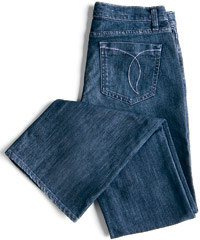
Bono and Ali Hewson
|
|
In her new book, Fugitive Denim (W. W. Norton and Co., $26.95), Rachel Louise Snyder explores the complexities of the global marketplace by trailing a quintessential product: jeans. Snyder, 38, grew up in the western suburbs but now divides her time between Phnom Penh, Cambodia, her base for a freelance reporting career focused on Asia, and an apartment in Uptown. Chicago reached her by phone in Cambodia, where garment workers assemble clothes for salaries that start around $50 a month.
Q: You wanted to follow one pair of jeans from cotton field to closet but discovered that the “Made in . . .” label isn’t what it seems. Is it ever really possible to know the origin of jeans?
A: It would be possible to figure it out if they were from a very small company, but, even then, the problem is the cotton, which probably came from multiple [countries] and got woven together.
 Q: You write a lot about the high-end Edun line, launched by Bono and his wife, Ali Hewson. With high labor standards in its factories in Africa, Edun, like the Gap, is part of the “altruistic commerce” trend. Is social consciousness just a marketing angle?
Q: You write a lot about the high-end Edun line, launched by Bono and his wife, Ali Hewson. With high labor standards in its factories in Africa, Edun, like the Gap, is part of the “altruistic commerce” trend. Is social consciousness just a marketing angle? A: I’ve lived in a Third World country and, you know, we can be as cynical as we want about where the aid comes from, but the people who are receiving that aid are not. They don’t care if it comes from you buying a T-shirt. . . . Of course there is something a little bit nauseating about the concept, but a lot of people probably wouldn’t give money to these causes if Bono or someone weren’t telling them to.
Q: Speaking of Bono, he and his wife turn up a lot in the book. Do you guys hang out?
A: No, no. I met him once for 30 seconds.
|
|
Q: Edun jeans use organic cotton, which takes more land, water, and labor to grow. Is there any such thing as a truly “sustainable” pair of jeans?
A: It’s really frustrating, isn’t it? I was hoping for those answers, but it’s endlessly complicated.
Q: Jeans cost about $20 to make. What’s with all the $150 pairs?
A: That $20 is only for production. It doesn’t take into account design or marketing.
Q: In Cambodia, access to the U.S. market has been explicitly linked to good labor standards. Yet the Cambodian garment workers you interview don’t seem particularly happy with their situations.
A: As good as the standards and conditions are, they’re not paid very much. For them to be paid more, the costs would rise and the country wouldn’t be as competitive.
Q: The average American woman owns eight pairs of jeans. How many do you own?
A: One. But it’s not because I’m so conservative about my consumer behavior. I live in a tropical climate. They’re not very practical here.
Photography: (book) blackbox studios, inc., (SNYDER) courtesy of Rachel Snyder, (Bono and ali) © Tammie Arroyo / AFF-USA.COM, (jeans) Blackbox studios, inc.




